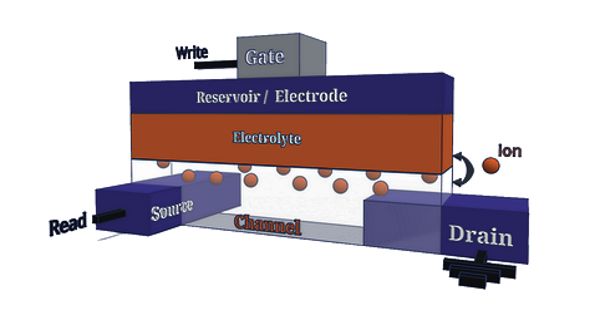Electrochemical random access memory (ECRAM) is a novel type of non-volatile memory (NVM) to provide acceleration for the training of deep neural networks (DNNs). ECRAM is a type of non-volatile memory (NVM) with multiple levels per cell (MLC) designed for deep learning analog acceleration. ECRAM is based on the reversible electrochemical intercalation of an ion into a host material, which causes a change in electrical resistance. An ECRAM cell is a three-terminal device composed of a conductive channel, an insulating electrolyte, an ionic reservoir, and metal contacts. Compared to other NVMs such as phase-change memory (PCM) or resistive random access memory (ReRAM), ECRAM provides more symmetric and deterministic potentiation and depression.
Electrochemical Random-Access Memory (ECRAM) is a type of non-volatile memory (NVM) with multiple levels per cell (MLC) designed for deep learning analog acceleration. It is based on the reversible electrochemical intercalation of an ion into a host material, which causes a change in electrical resistance.
Resistance random access memory (RRAM) has attracted wide attentions due to its simple structure, low power consumption, favorable scalability, and fast switching. The resistance of the channel is modulated by ionic exchange at the interface between the channel and the electrolyte upon application of an electric field. Especially, electrochemical metallization memory (ECM) devices, based on the migration of Ag or Cu ions, are promising, due to their maturity with respect to industrialization and the proven scalability potential. The charge-transfer process allows both for state retention in the absence of applied power, and for programming of multiple distinct levels, both differentiating ECRAM operation from the one of a field-effect transistor (FET). The ECM device consists of an electrode made from an electrochemically active electrode metal, such as Ag or Cu, an electrochemically inert counter electrode, such as Pt, Ir, W, or Au, and a thin film of a solid electrolyte sandwiched between both electrodes.
The write operation is deterministic and can result in symmetrical potentiation and depression, making ECRAM arrays attractive for acting as artificial synaptic weights in physical implementations of artificial neural networks (ANN). For the resistance change mechanism of ECM devices, a model which is based on the electrochemical dissolution and formation of conductive filaments in the solid electrolyte layer is adopted to explain the resistance change. The technology challenges include open circuit potential (OCP) and semiconductor foundry compatibility associated with energy materials.
Electrochemistry plays a strong role for such charge transport in many devices, including the new generations of resistive random access memory involving metal/thin-insulator/nanomaterial constructs, as well as in photocatalytic systems, and in surface (bio)chemical sensors. Notably, Sandia National Laboratories designed a lithium-based cell inspired by solid-state battery materials, Stanford University built an organic proton-based cell, and International Business Machines (IBM) demonstrated in-memory selector-free parallel programming for a logistic regression task in an array of metal-oxide ECRAM designed for insertion in the back end of line (BEOL).
Information Source:
















